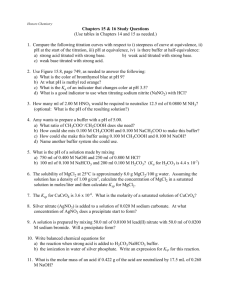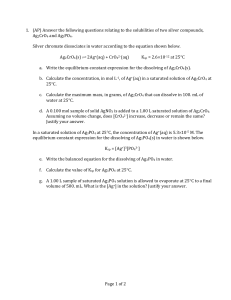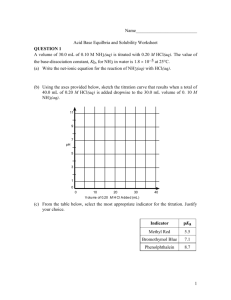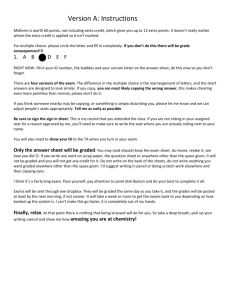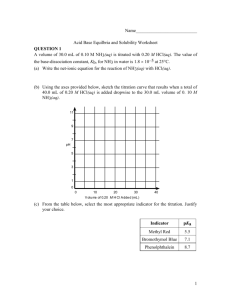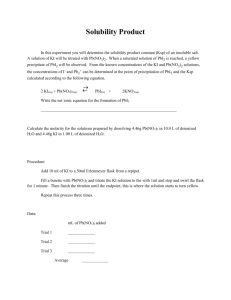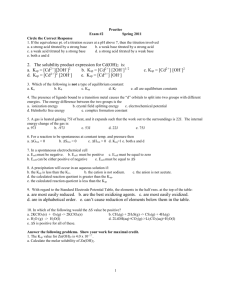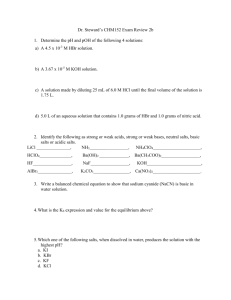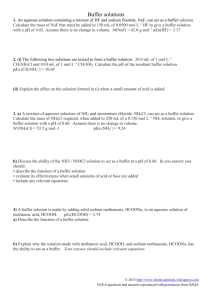Unit 9
advertisement
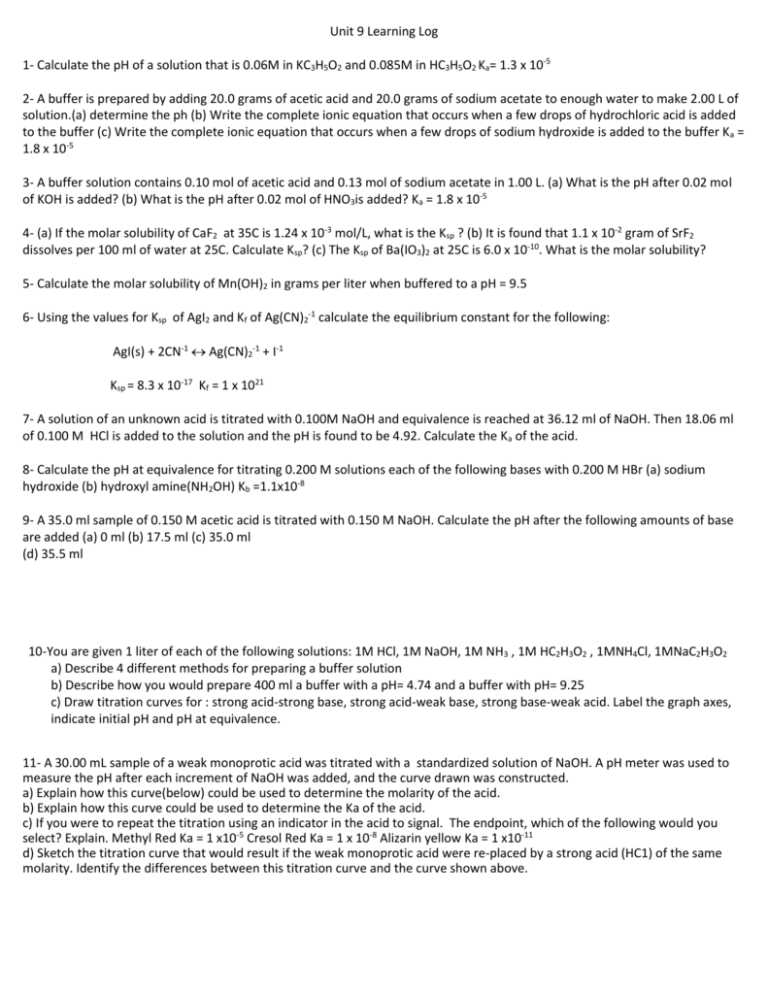
Unit 9 Learning Log 1- Calculate the pH of a solution that is 0.06M in KC3H5O2 and 0.085M in HC3H5O2 Ka= 1.3 x 10-5 2- A buffer is prepared by adding 20.0 grams of acetic acid and 20.0 grams of sodium acetate to enough water to make 2.00 L of solution.(a) determine the ph (b) Write the complete ionic equation that occurs when a few drops of hydrochloric acid is added to the buffer (c) Write the complete ionic equation that occurs when a few drops of sodium hydroxide is added to the buffer Ka = 1.8 x 10-5 3- A buffer solution contains 0.10 mol of acetic acid and 0.13 mol of sodium acetate in 1.00 L. (a) What is the pH after 0.02 mol of KOH is added? (b) What is the pH after 0.02 mol of HNO3is added? Ka = 1.8 x 10-5 4- (a) If the molar solubility of CaF2 at 35C is 1.24 x 10-3 mol/L, what is the Ksp ? (b) It is found that 1.1 x 10-2 gram of SrF2 dissolves per 100 ml of water at 25C. Calculate Ksp? (c) The Ksp of Ba(IO3)2 at 25C is 6.0 x 10-10. What is the molar solubility? 5- Calculate the molar solubility of Mn(OH)2 in grams per liter when buffered to a pH = 9.5 6- Using the values for Ksp of AgI2 and Kf of Ag(CN)2-1 calculate the equilibrium constant for the following: AgI(s) + 2CN-1 Ag(CN)2-1 + I-1 Ksp = 8.3 x 10-17 Kf = 1 x 1021 7- A solution of an unknown acid is titrated with 0.100M NaOH and equivalence is reached at 36.12 ml of NaOH. Then 18.06 ml of 0.100 M HCl is added to the solution and the pH is found to be 4.92. Calculate the Ka of the acid. 8- Calculate the pH at equivalence for titrating 0.200 M solutions each of the following bases with 0.200 M HBr (a) sodium hydroxide (b) hydroxyl amine(NH2OH) Kb =1.1x10-8 9- A 35.0 ml sample of 0.150 M acetic acid is titrated with 0.150 M NaOH. Calculate the pH after the following amounts of base are added (a) 0 ml (b) 17.5 ml (c) 35.0 ml (d) 35.5 ml 10-You are given 1 liter of each of the following solutions: 1M HCl, 1M NaOH, 1M NH3 , 1M HC2H3O2 , 1MNH4Cl, 1MNaC2H3O2 a) Describe 4 different methods for preparing a buffer solution b) Describe how you would prepare 400 ml a buffer with a pH= 4.74 and a buffer with pH= 9.25 c) Draw titration curves for : strong acid-strong base, strong acid-weak base, strong base-weak acid. Label the graph axes, indicate initial pH and pH at equivalence. 11- A 30.00 mL sample of a weak monoprotic acid was titrated with a standardized solution of NaOH. A pH meter was used to measure the pH after each increment of NaOH was added, and the curve drawn was constructed. a) Explain how this curve(below) could be used to determine the molarity of the acid. b) Explain how this curve could be used to determine the Ka of the acid. c) If you were to repeat the titration using an indicator in the acid to signal. The endpoint, which of the following would you select? Explain. Methyl Red Ka = 1 x10-5 Cresol Red Ka = 1 x 10-8 Alizarin yellow Ka = 1 x10-11 d) Sketch the titration curve that would result if the weak monoprotic acid were re-placed by a strong acid (HC1) of the same molarity. Identify the differences between this titration curve and the curve shown above. 12- The equations and constants for the dissociation of three different acids are given below. HC03- < = > H+ + C03-2 Ka =4.2 x 10-7 H2PO4- < = > H+ + HP04-2 Ka = 6.2 x 10-8 HS04- < == > H+ + S04-2 Ka = 1.3 x 10-2 a) From the systems above, identify the conjugate pair that is best for preparing a buffer with a pH of 7.2. Explain your choice. b) Explain briefly how you would prepare the buffer solution described in (a) with the conjugate pair you have chosen. c) If the concentration of both the acid and the conjugate base you have chosen were doubled, how would the pH be affected? Explain how the capacity of the buffer is affected by this change in concentrations of acid and base. d) Explain briefly how you could prepare the buffer solution in (a) if you had available the solid salt of only one member of the conjugate pair and solutions of a strong acid and a strong base. HOBr(aq) H+(aq) + OBr-(aq) Ka = 2.3 x 10-9 13- Hypobromic Acid, HOBr, is a weak acid that dissociates in water, as represented by the equation above. a) Calculate the value of [H+] in an HOBr solution that has a pH of 4.95. b) Write the equilibrium constant expression for the ionization of HOBr in water, then calculate the concentration of HOBr (aq) in an HOBr solution that has [H+] equal to 1.8 x 10-5 M c) A solution of Ba(OH)2 is titrated into a solution of HOBr. 1) Calculate the volume of 0.115 M Ba(OH)2(aq) needed to reach the equivalence point when titrated into 65.0 mL sample of 0.146 M HOBr(aq). 2) Indicate whether the pH at the equivalence point is less than 7, equal to 7, or greater than 7. Explain d) Calculate the number of moles of NaOBr (s) that would have to be added to 125 mL of 0.160 M HOBr to produce a buffer solution with [H+] = 5.00 x 10-9 M. Assume that volume change is negligible. e) HOBr is a weaker acid than HbrO3 , account for this fact in terms of molecular structure. C6H 5NH2(aq) + H2O(l) C6H5NH3+(aq) + OH-(aq) 14- Aniline, a weak base, reacts with water according to the reaction represented above. a) Write the equilibrium constant expression, Kb , for the reaction represented above. b) A sample of aniline is dissolved in water to produce 25.0 mL of a 0.10 M solution. The pH of the solution is 8.82. Calculate the equilibrium constant, Kb, for this reaction. c) The solution prepared in part (b) is titrated with 0.10 M HC1. Calculate the pH of the solution when 5.0 mL of the acid has been added. lculate the pH at the equivalence point in the titration in part (c). e) The pKa values for several indicator are given below. Which of the indicators listed is most suitable for this titration? Justify you answer. Indicator pKa Erythrosine 3 Litmus 7 Thymolphtalein 10 15- Answer the following questions relating to the solubility of the chlorides of silver and lead : a) At 100C, 8.9 x 10-5 g of AgCl(s) will dissolve in 100 mL of water. 1) Write the equation for the dissociation of AgCl(s) in water. 2) Calculate the solubility, in mol L-1, of AgCl(s) in water at 10°C. 3) Calculate the value of the solubility product constant, Ksp, for AgCl (s) at 10°C. b) At 25 C, the value of Ksp for PbC12(s) is 1.6 x10-5 and the value of Ksp for AgCl(s) is 1.8 x 10-10 1) If 60.0mL of 0.0400 M NaCl (aq) is added to 60.0 mL of 0.0300 M Pb(NO3)2 (aq) will a precipitate form? Assume that the volumes are additive. Show calculations to support your answer. c) Calculate the equilibrium value of Pb+2(aq) in 1.00 L of saturated PbC12 solution to which 0.250 moles of NaCl(s) has been added. Assume that no volume change occurs. d) If 0.100 M NaCl(aq) is added slowly to a beaker containing both 0.120 M AgNO3(aq) and 0.150 M Pb(NO3)2 (aq) at 25°C, which will precipitate fIrst, AgCl(s) or PbC12 ? Show calculations to support your answer. 16- Answer the following questions relating to the solubilities of two silver compounds, Ag2CrO4 and Ag3PO4 Silver chromate dissociates in water according to the equation shown below. Ag2CrO4 (s) 2Ag+(aq) + CrO4-2(aq) Ksp = 2.6 x 10-12 at 25 C a) Write the equilibrium constant expression for the dissolving of Ag2CrO4(s) b) Calculate the concentration, in mol L-1, of Ag+(aq) in a saturated solution ofAg2CrO4 at 25C. c) Calculate the maximum mass, in grams, of Ag2CrO4 that can dissolve in 100.0 mL of water at 25C d) A 0.100 mol sample of solid AgNO3 is added to a 1.00 L saturated solution of Ag2CrO4. Assuming no volume change, does [CrO4-2] increase, decrease, or remain the same? Justify your answer In a saturated solution of Ag3PO4 at 25C , the concentration of Ag+(aq) is 5.3 x 10-5 M. the equilibrium constant expression for the dissolving of Ag2PO4 (s) in water is shown below. Ksp = [Ag+]3 [ PO4-3] e) Write the balanced equation for the dissolving of Ag3PO4 in water f) Calculate the value of Ksp for Ag3PO4 at 25C. g) A 1.00 L sample of saturated Ag3PO4 solution is allowed to evaporate at 25C to a final volume of 500.mL. What is [Ag+] in the solution? Justify your answer.
